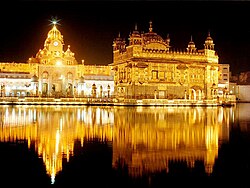

The post-Mughal era was dominated by the rise of the Maratha suzerainty as other small regional states (mostly post-Mughal tributary states) emerged, and also by the increasing activities of European powers (see colonial era below). The Maratha Kingdom was founded and consolidated by Shivaji. By the 18th century, it had transformed itself into the Maratha Empire under the rule of the Peshwas. By 1760, the Empire had stretched across practically the entire subcontinent. This expansion was brought to an end by the defeat of the Marathas by an Afghan army led by Ahmad Shah Abdali at the Third Battle of Panipat (1761). The last Peshwa, Baji Rao II, was defeated by the British in the Third Anglo-Maratha War.
Mysore was a kingdom of southern India, which was founded around 1400 CE by the Wodeyar dynasty. The rule of the Wodeyars was interrupted by Hyder Ali and his son Tippu Sultan. Under their rule Mysore fought a series of wars sometimes against the combined forces of the British and Marathas, but mostly against the British with some aid or promise of aid from the French. Hyderabad was founded by the Qutb Shahi dynasty of Golconda in 1591. Following a brief Mughal rule, Asif Jah, a Mughal official, seized control of Hyderabad declaring himself Nizam-al-Mulk of Hyderabad in 1724. It was ruled by a hereditary Nizam from 1724 until 1948. Both Mysore and Hyderabad became princely states in British India.
The Punjabi kingdom, ruled by members of the Sikh religion, was a political entity that governed the region of modern day Punjab. This was among the last areas of the subcontinent to be conquered by the British. The Anglo-Sikh wars marked the downfall of the Sikh Empire. Around the 18th century modern Nepal was formed by Gorkha rulers, and the Shahs and the Ranas very strictly maintained their national identity and integrity.

No comments:
Post a Comment